Detailed Report on Toyota's Management and Operations - Unit 4
VerifiedAdded on 2020/10/22
|17
|5275
|249
Report
AI Summary
This report provides a comprehensive analysis of Toyota's management and operations, focusing on the roles and characteristics of leaders and managers within the organization. It explores the application of leadership and management roles in various situations, particularly in resolving conflicts and managing time effectively. The report delves into different leadership and management theories, including transformational leadership and classical management theory, and evaluates their relevance to Toyota's context. Key approaches to operations management, such as process design, capacity management, and scheduling, are also examined, along with the factors within the business environment that impact operational management and decision-making. The report highlights the importance of operations management in achieving business objectives and emphasizes the similarities and differences between managers and leaders within Toyota. It also includes a PESTLE analysis to assess the influence of external factors on the company's operations. Overall, the report offers insights into Toyota's management practices and operational strategies.
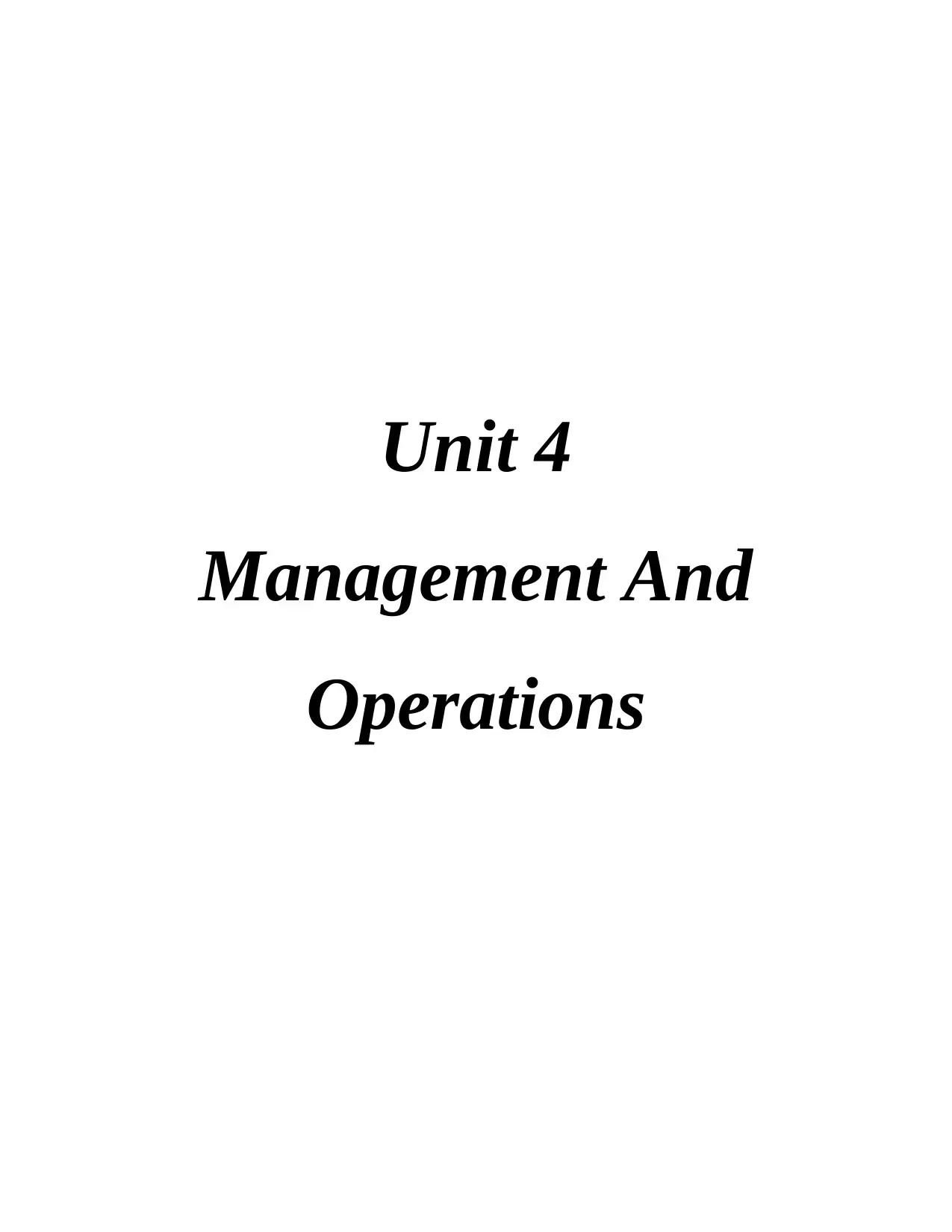
Unit 4
Management And
Operations
Management And
Operations
Paraphrase This Document
Need a fresh take? Get an instant paraphrase of this document with our AI Paraphraser
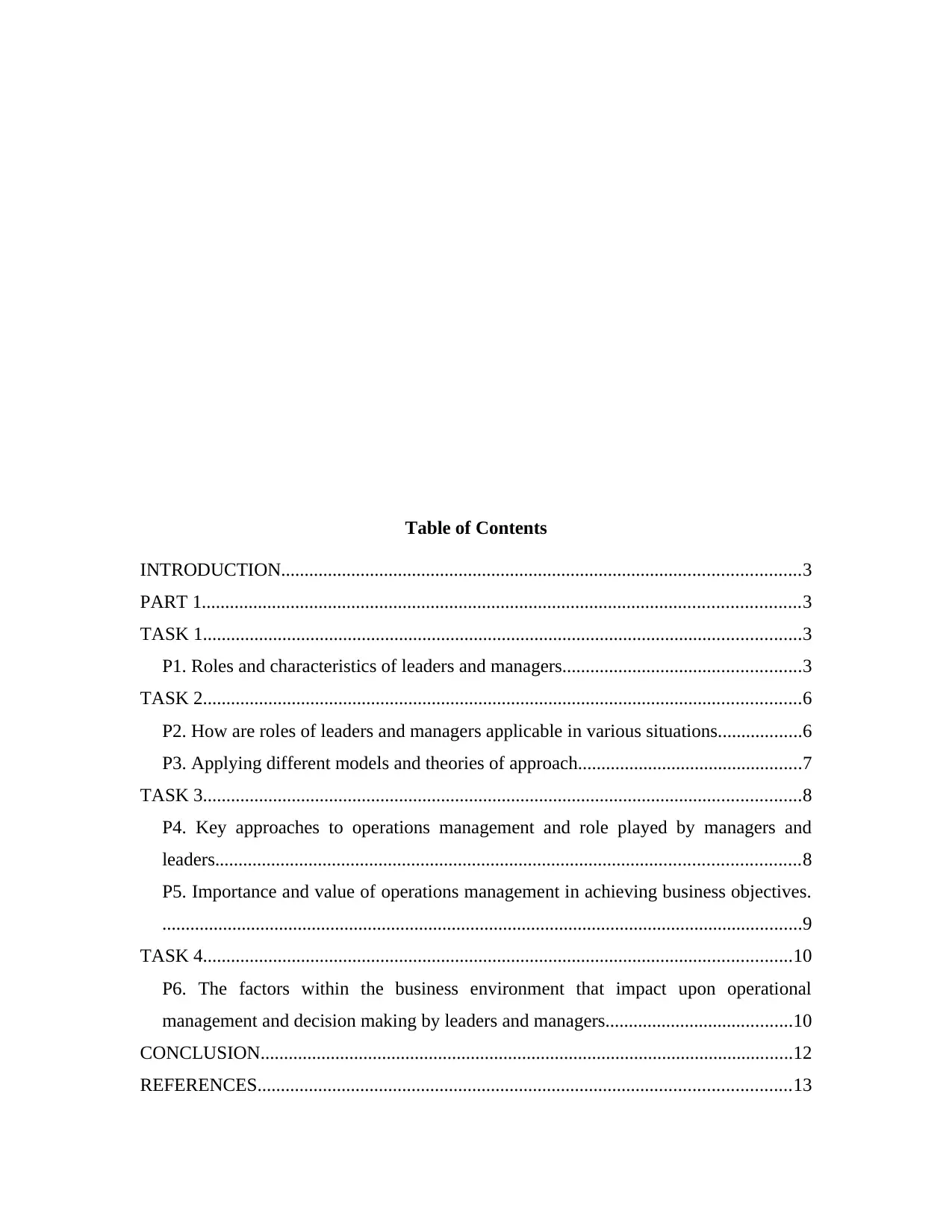
Table of Contents
INTRODUCTION...............................................................................................................3
PART 1................................................................................................................................3
TASK 1................................................................................................................................3
P1. Roles and characteristics of leaders and managers...................................................3
TASK 2................................................................................................................................6
P2. How are roles of leaders and managers applicable in various situations..................6
P3. Applying different models and theories of approach................................................7
TASK 3................................................................................................................................8
P4. Key approaches to operations management and role played by managers and
leaders.............................................................................................................................8
P5. Importance and value of operations management in achieving business objectives.
.........................................................................................................................................9
TASK 4..............................................................................................................................10
P6. The factors within the business environment that impact upon operational
management and decision making by leaders and managers........................................10
CONCLUSION..................................................................................................................12
REFERENCES..................................................................................................................13
INTRODUCTION...............................................................................................................3
PART 1................................................................................................................................3
TASK 1................................................................................................................................3
P1. Roles and characteristics of leaders and managers...................................................3
TASK 2................................................................................................................................6
P2. How are roles of leaders and managers applicable in various situations..................6
P3. Applying different models and theories of approach................................................7
TASK 3................................................................................................................................8
P4. Key approaches to operations management and role played by managers and
leaders.............................................................................................................................8
P5. Importance and value of operations management in achieving business objectives.
.........................................................................................................................................9
TASK 4..............................................................................................................................10
P6. The factors within the business environment that impact upon operational
management and decision making by leaders and managers........................................10
CONCLUSION..................................................................................................................12
REFERENCES..................................................................................................................13

INTRODUCTION
Operations management is a quite vast subject which deals in management
practices and functions that are related to production process undertaken in a business
concern and its designing and controlling as well. Basically, operations management is a
process where raw materials get converted into finished products and services. Also, it
has been noticed that leaders and managers play a quite important part in the functioning
of an organisation (Boyd and Dougherty, 2016). This report has been framed on a
Japanese organisation Toyota. It is basically a Japanese multinational automotive
manufacturer and car dealer with its headquarters in Toyota city, Aichi, Japan. Toyota is
sixth largest business entity in the world as per its revenue. In the present report, roles
and characteristics of leaders as well as managers has been specified. Also, the various
approaches of operations management have been mentioned. This report also throws light
on leadership approaches that are discussed here. Furthermore, pestle analysis also has
been done in this report which emphasises on effect of external factors.
PART 1
TASK 1
P1. Roles and characteristics of leaders and managers.
Leader: A leader is an individual who is meant to motivate and influence
behaviour of employees so that they can perform business operations effectively. Leaders
in Toyota are known to influence performance of their employees by using their
charismatic personality. This helps them in timely achievement of goals and objectives
(Ellitan, 2017). Also, they direct and guide employees for maintaining efficiency
standards.
Role played by leaders:
Leaders provide a clearer view towards aims and objectives of a business concern
so that employees can function accordingly.
They are known for maintaining effectiveness and efficiency in business
operations of Toyota by undertaking policies and strategies.
Operations management is a quite vast subject which deals in management
practices and functions that are related to production process undertaken in a business
concern and its designing and controlling as well. Basically, operations management is a
process where raw materials get converted into finished products and services. Also, it
has been noticed that leaders and managers play a quite important part in the functioning
of an organisation (Boyd and Dougherty, 2016). This report has been framed on a
Japanese organisation Toyota. It is basically a Japanese multinational automotive
manufacturer and car dealer with its headquarters in Toyota city, Aichi, Japan. Toyota is
sixth largest business entity in the world as per its revenue. In the present report, roles
and characteristics of leaders as well as managers has been specified. Also, the various
approaches of operations management have been mentioned. This report also throws light
on leadership approaches that are discussed here. Furthermore, pestle analysis also has
been done in this report which emphasises on effect of external factors.
PART 1
TASK 1
P1. Roles and characteristics of leaders and managers.
Leader: A leader is an individual who is meant to motivate and influence
behaviour of employees so that they can perform business operations effectively. Leaders
in Toyota are known to influence performance of their employees by using their
charismatic personality. This helps them in timely achievement of goals and objectives
(Ellitan, 2017). Also, they direct and guide employees for maintaining efficiency
standards.
Role played by leaders:
Leaders provide a clearer view towards aims and objectives of a business concern
so that employees can function accordingly.
They are known for maintaining effectiveness and efficiency in business
operations of Toyota by undertaking policies and strategies.
⊘ This is a preview!⊘
Do you want full access?
Subscribe today to unlock all pages.

Trusted by 1+ million students worldwide

Characteristics of a leader:
Leaders motivate employees by their influencing personality and set ideals for
their subordinates as well.
Leaders of Toyota have a certain patience quotient in their personality which
helps them in raising desire level of employees.
Managers: A manager refers to an individual who is absolute authority for
managing tasks assigned to them and maintaining effectiveness in business functions as
well. Managers in Toyota take instructions from their employers and further pass it on to
subordinates. A manager also acts as a coordinating link between two and lower
management (Eraki, 2015).
Role played by managers:
A manager main function is to control and manage functions in an organisation.
In case of Toyota, its manager acts as a figurehead and coordinator.
A manager also communicates important data and information to its subordinates.
In relation to Toyota, manager acts as a monitor, spokesperson and disseminator
as well.
Characteristics of managers:
Managers in Toyota have a very innovative and creative personality and they
further use this trait in forming policies as well.
Managers should also ample amount of skills such as interpersonal, time
management, decision making etc. This will help in maintaining effectiveness in
an organisation.
Similarities between managers and leaders of Toyota:
Both leaders and managers work towards a common goal i.e. growth and
profitability of a business concern (Fan, Liu and Zhang, 2015).
Both leaders and managers work towards raising morale of employees and also
participate in decision making as well.
Differences between a manager and a leader
Basis of comparison Managers Leaders
Characteristics Characteristics of managers in
Toyota include time
Characteristic features of
leaders in Toyota include being
Leaders motivate employees by their influencing personality and set ideals for
their subordinates as well.
Leaders of Toyota have a certain patience quotient in their personality which
helps them in raising desire level of employees.
Managers: A manager refers to an individual who is absolute authority for
managing tasks assigned to them and maintaining effectiveness in business functions as
well. Managers in Toyota take instructions from their employers and further pass it on to
subordinates. A manager also acts as a coordinating link between two and lower
management (Eraki, 2015).
Role played by managers:
A manager main function is to control and manage functions in an organisation.
In case of Toyota, its manager acts as a figurehead and coordinator.
A manager also communicates important data and information to its subordinates.
In relation to Toyota, manager acts as a monitor, spokesperson and disseminator
as well.
Characteristics of managers:
Managers in Toyota have a very innovative and creative personality and they
further use this trait in forming policies as well.
Managers should also ample amount of skills such as interpersonal, time
management, decision making etc. This will help in maintaining effectiveness in
an organisation.
Similarities between managers and leaders of Toyota:
Both leaders and managers work towards a common goal i.e. growth and
profitability of a business concern (Fan, Liu and Zhang, 2015).
Both leaders and managers work towards raising morale of employees and also
participate in decision making as well.
Differences between a manager and a leader
Basis of comparison Managers Leaders
Characteristics Characteristics of managers in
Toyota include time
Characteristic features of
leaders in Toyota include being
Paraphrase This Document
Need a fresh take? Get an instant paraphrase of this document with our AI Paraphraser
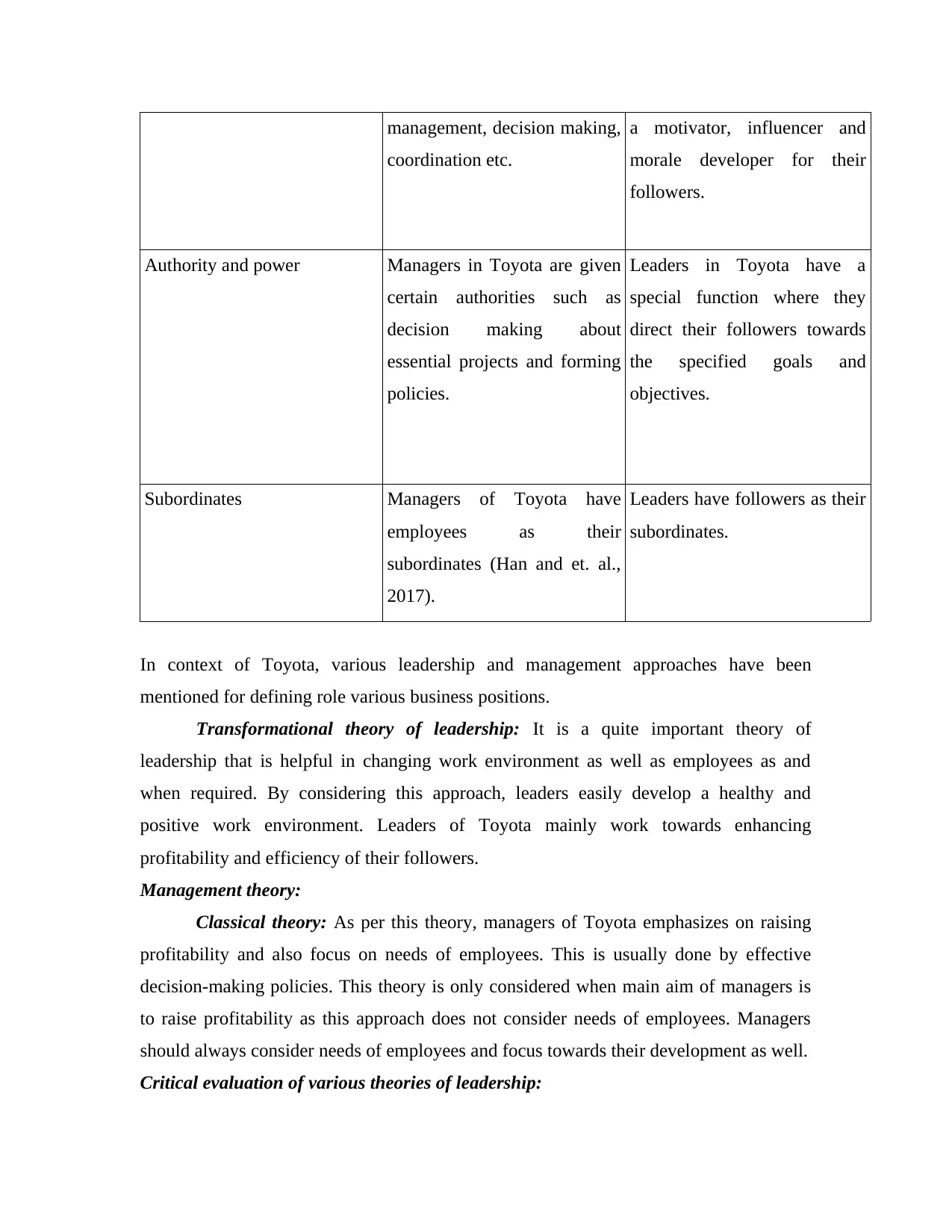
management, decision making,
coordination etc.
a motivator, influencer and
morale developer for their
followers.
Authority and power Managers in Toyota are given
certain authorities such as
decision making about
essential projects and forming
policies.
Leaders in Toyota have a
special function where they
direct their followers towards
the specified goals and
objectives.
Subordinates Managers of Toyota have
employees as their
subordinates (Han and et. al.,
2017).
Leaders have followers as their
subordinates.
In context of Toyota, various leadership and management approaches have been
mentioned for defining role various business positions.
Transformational theory of leadership: It is a quite important theory of
leadership that is helpful in changing work environment as well as employees as and
when required. By considering this approach, leaders easily develop a healthy and
positive work environment. Leaders of Toyota mainly work towards enhancing
profitability and efficiency of their followers.
Management theory:
Classical theory: As per this theory, managers of Toyota emphasizes on raising
profitability and also focus on needs of employees. This is usually done by effective
decision-making policies. This theory is only considered when main aim of managers is
to raise profitability as this approach does not consider needs of employees. Managers
should always consider needs of employees and focus towards their development as well.
Critical evaluation of various theories of leadership:
coordination etc.
a motivator, influencer and
morale developer for their
followers.
Authority and power Managers in Toyota are given
certain authorities such as
decision making about
essential projects and forming
policies.
Leaders in Toyota have a
special function where they
direct their followers towards
the specified goals and
objectives.
Subordinates Managers of Toyota have
employees as their
subordinates (Han and et. al.,
2017).
Leaders have followers as their
subordinates.
In context of Toyota, various leadership and management approaches have been
mentioned for defining role various business positions.
Transformational theory of leadership: It is a quite important theory of
leadership that is helpful in changing work environment as well as employees as and
when required. By considering this approach, leaders easily develop a healthy and
positive work environment. Leaders of Toyota mainly work towards enhancing
profitability and efficiency of their followers.
Management theory:
Classical theory: As per this theory, managers of Toyota emphasizes on raising
profitability and also focus on needs of employees. This is usually done by effective
decision-making policies. This theory is only considered when main aim of managers is
to raise profitability as this approach does not consider needs of employees. Managers
should always consider needs of employees and focus towards their development as well.
Critical evaluation of various theories of leadership:

Trait theory of leadership: In context of Toyota, many a times the demand for its
products and services increases which creates a workload on employees and hampers
their functioning. Hence, leader’s main role is to deal with complicated situations ad also
motivate their employees (Idris, 2016).
Charismatic theory of leadership: Leaders of Toyota are known for their
influential and charismatic personality. This further helps them in inspiring and
motivating employees in Toyota. Many a times during conflicts morale level of
employees gets down. In such situations, leaders can use this approach for motivating
employees.
Key management operations:
Process design: Process design is an important key term that explains choice and
sequencing of units so as to achieve desired results in context of physical as well
as chemical transformation as well.
Capacity management: It is an important process which involves practices of
right sizing basic IT resources so as to meet current as well as future
requirements.
Scheduling: It is a process which infuses arranging, controlling as well as
optimizing work as well as workload . This process is mainly used for allocating
various resources such as human resource, plant and machinery, purchase
decisions etc.
TASK 2
P2. How are roles of leaders and managers applicable in various situations.
Leaders as well as managers perform various essential functions such as inspiring
and influencing followers, decision making, policy formation and delegating authority.
All these functions combined help in maintaining efficiency of employees and timely
achieving goals and objectives. Managers in Toyota undertake various activities such as
planning about important projects, assigning work to subordinates based on their skills
etc. Many a times they may have to face certain complex situations due to peak time or
conflicts, here managers and leaders need to perform in absolute collaboration. This will
help them in smooth functioning and timely achievement of objectives of their business.
products and services increases which creates a workload on employees and hampers
their functioning. Hence, leader’s main role is to deal with complicated situations ad also
motivate their employees (Idris, 2016).
Charismatic theory of leadership: Leaders of Toyota are known for their
influential and charismatic personality. This further helps them in inspiring and
motivating employees in Toyota. Many a times during conflicts morale level of
employees gets down. In such situations, leaders can use this approach for motivating
employees.
Key management operations:
Process design: Process design is an important key term that explains choice and
sequencing of units so as to achieve desired results in context of physical as well
as chemical transformation as well.
Capacity management: It is an important process which involves practices of
right sizing basic IT resources so as to meet current as well as future
requirements.
Scheduling: It is a process which infuses arranging, controlling as well as
optimizing work as well as workload . This process is mainly used for allocating
various resources such as human resource, plant and machinery, purchase
decisions etc.
TASK 2
P2. How are roles of leaders and managers applicable in various situations.
Leaders as well as managers perform various essential functions such as inspiring
and influencing followers, decision making, policy formation and delegating authority.
All these functions combined help in maintaining efficiency of employees and timely
achieving goals and objectives. Managers in Toyota undertake various activities such as
planning about important projects, assigning work to subordinates based on their skills
etc. Many a times they may have to face certain complex situations due to peak time or
conflicts, here managers and leaders need to perform in absolute collaboration. This will
help them in smooth functioning and timely achievement of objectives of their business.
⊘ This is a preview!⊘
Do you want full access?
Subscribe today to unlock all pages.

Trusted by 1+ million students worldwide
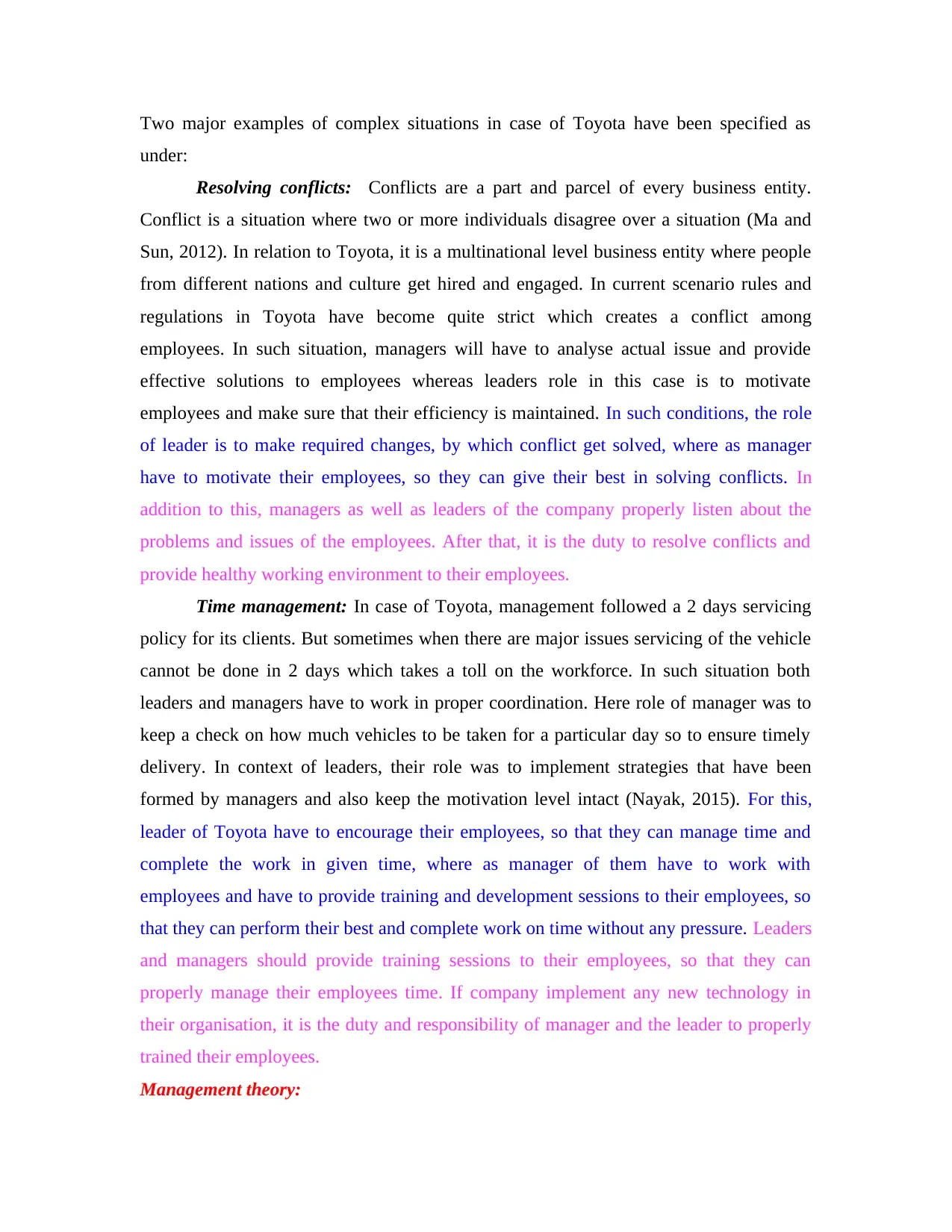
Two major examples of complex situations in case of Toyota have been specified as
under:
Resolving conflicts: Conflicts are a part and parcel of every business entity.
Conflict is a situation where two or more individuals disagree over a situation (Ma and
Sun, 2012). In relation to Toyota, it is a multinational level business entity where people
from different nations and culture get hired and engaged. In current scenario rules and
regulations in Toyota have become quite strict which creates a conflict among
employees. In such situation, managers will have to analyse actual issue and provide
effective solutions to employees whereas leaders role in this case is to motivate
employees and make sure that their efficiency is maintained. In such conditions, the role
of leader is to make required changes, by which conflict get solved, where as manager
have to motivate their employees, so they can give their best in solving conflicts. In
addition to this, managers as well as leaders of the company properly listen about the
problems and issues of the employees. After that, it is the duty to resolve conflicts and
provide healthy working environment to their employees.
Time management: In case of Toyota, management followed a 2 days servicing
policy for its clients. But sometimes when there are major issues servicing of the vehicle
cannot be done in 2 days which takes a toll on the workforce. In such situation both
leaders and managers have to work in proper coordination. Here role of manager was to
keep a check on how much vehicles to be taken for a particular day so to ensure timely
delivery. In context of leaders, their role was to implement strategies that have been
formed by managers and also keep the motivation level intact (Nayak, 2015). For this,
leader of Toyota have to encourage their employees, so that they can manage time and
complete the work in given time, where as manager of them have to work with
employees and have to provide training and development sessions to their employees, so
that they can perform their best and complete work on time without any pressure. Leaders
and managers should provide training sessions to their employees, so that they can
properly manage their employees time. If company implement any new technology in
their organisation, it is the duty and responsibility of manager and the leader to properly
trained their employees.
Management theory:
under:
Resolving conflicts: Conflicts are a part and parcel of every business entity.
Conflict is a situation where two or more individuals disagree over a situation (Ma and
Sun, 2012). In relation to Toyota, it is a multinational level business entity where people
from different nations and culture get hired and engaged. In current scenario rules and
regulations in Toyota have become quite strict which creates a conflict among
employees. In such situation, managers will have to analyse actual issue and provide
effective solutions to employees whereas leaders role in this case is to motivate
employees and make sure that their efficiency is maintained. In such conditions, the role
of leader is to make required changes, by which conflict get solved, where as manager
have to motivate their employees, so they can give their best in solving conflicts. In
addition to this, managers as well as leaders of the company properly listen about the
problems and issues of the employees. After that, it is the duty to resolve conflicts and
provide healthy working environment to their employees.
Time management: In case of Toyota, management followed a 2 days servicing
policy for its clients. But sometimes when there are major issues servicing of the vehicle
cannot be done in 2 days which takes a toll on the workforce. In such situation both
leaders and managers have to work in proper coordination. Here role of manager was to
keep a check on how much vehicles to be taken for a particular day so to ensure timely
delivery. In context of leaders, their role was to implement strategies that have been
formed by managers and also keep the motivation level intact (Nayak, 2015). For this,
leader of Toyota have to encourage their employees, so that they can manage time and
complete the work in given time, where as manager of them have to work with
employees and have to provide training and development sessions to their employees, so
that they can perform their best and complete work on time without any pressure. Leaders
and managers should provide training sessions to their employees, so that they can
properly manage their employees time. If company implement any new technology in
their organisation, it is the duty and responsibility of manager and the leader to properly
trained their employees.
Management theory:
Paraphrase This Document
Need a fresh take? Get an instant paraphrase of this document with our AI Paraphraser

Classical theory: As per this theory, managers of Toyota emphasizes on raising
profitability and also focus on needs of employees. This is usually done by effective
decision-making policies. This theory is only considered when main aim of managers is
to raise profitability as this approach does not consider needs of employees. Managers
should always consider needs of employees and focus towards their development as well.
Leadership theory:
Contingency leadership theory- It is a leadership style which define about several
changing leadership style in context of a company according to different situation. In
different organisation, leader and manager apply a particular leadership style according to
the situation or which is flexible for the company at the time of operation. In context of
TOYOTA, the management of the company can use this theory of leadership styles as per
the situation.
Organisational situation and role of manager and role of manager in that:
Conflict situation: It is the situation that is occurred in TOYOTA when someone
perform discrimination as per their religions, gender etc. in order to solve this situation
both manager and leader plays various roles so that its employees perform can perform
their task effectually. For dealing with it, contingency is utilise through TOYOTA
manager as this support the systematic management of staff as well as perform as per its
business ethics. Manager role to solve disputes is that it formulate norms and regulations
regarding discrimination at work area. It also discuss the problems with employees then
take any decisions. Moreover role of leaders is to identify the root cause of the disputes
them encourage workers in order to solve conflicts so it can perform effectually. Herein,
leaders implies utilisation of system leadership theory as this aids in providing unbiased
disputes resolution advice as per the work.
Rapid changing situation: This is considered as the change in situation on
regular basis at TOYOTA, that impact their operations and performance. Thus, their
manager an leaders have to up to date its strategies as well as plans consequently.
Manager can apply situational approaches in order to deal with rapid changes in
circumstances. Herein, manager role is to formulate plan and strategies as per the
situation and trained their staff to accomplish objectives in effective manner. To manage
this kinds of situation Toyota manager implies the usages of system management
profitability and also focus on needs of employees. This is usually done by effective
decision-making policies. This theory is only considered when main aim of managers is
to raise profitability as this approach does not consider needs of employees. Managers
should always consider needs of employees and focus towards their development as well.
Leadership theory:
Contingency leadership theory- It is a leadership style which define about several
changing leadership style in context of a company according to different situation. In
different organisation, leader and manager apply a particular leadership style according to
the situation or which is flexible for the company at the time of operation. In context of
TOYOTA, the management of the company can use this theory of leadership styles as per
the situation.
Organisational situation and role of manager and role of manager in that:
Conflict situation: It is the situation that is occurred in TOYOTA when someone
perform discrimination as per their religions, gender etc. in order to solve this situation
both manager and leader plays various roles so that its employees perform can perform
their task effectually. For dealing with it, contingency is utilise through TOYOTA
manager as this support the systematic management of staff as well as perform as per its
business ethics. Manager role to solve disputes is that it formulate norms and regulations
regarding discrimination at work area. It also discuss the problems with employees then
take any decisions. Moreover role of leaders is to identify the root cause of the disputes
them encourage workers in order to solve conflicts so it can perform effectually. Herein,
leaders implies utilisation of system leadership theory as this aids in providing unbiased
disputes resolution advice as per the work.
Rapid changing situation: This is considered as the change in situation on
regular basis at TOYOTA, that impact their operations and performance. Thus, their
manager an leaders have to up to date its strategies as well as plans consequently.
Manager can apply situational approaches in order to deal with rapid changes in
circumstances. Herein, manager role is to formulate plan and strategies as per the
situation and trained their staff to accomplish objectives in effective manner. To manage
this kinds of situation Toyota manager implies the usages of system management
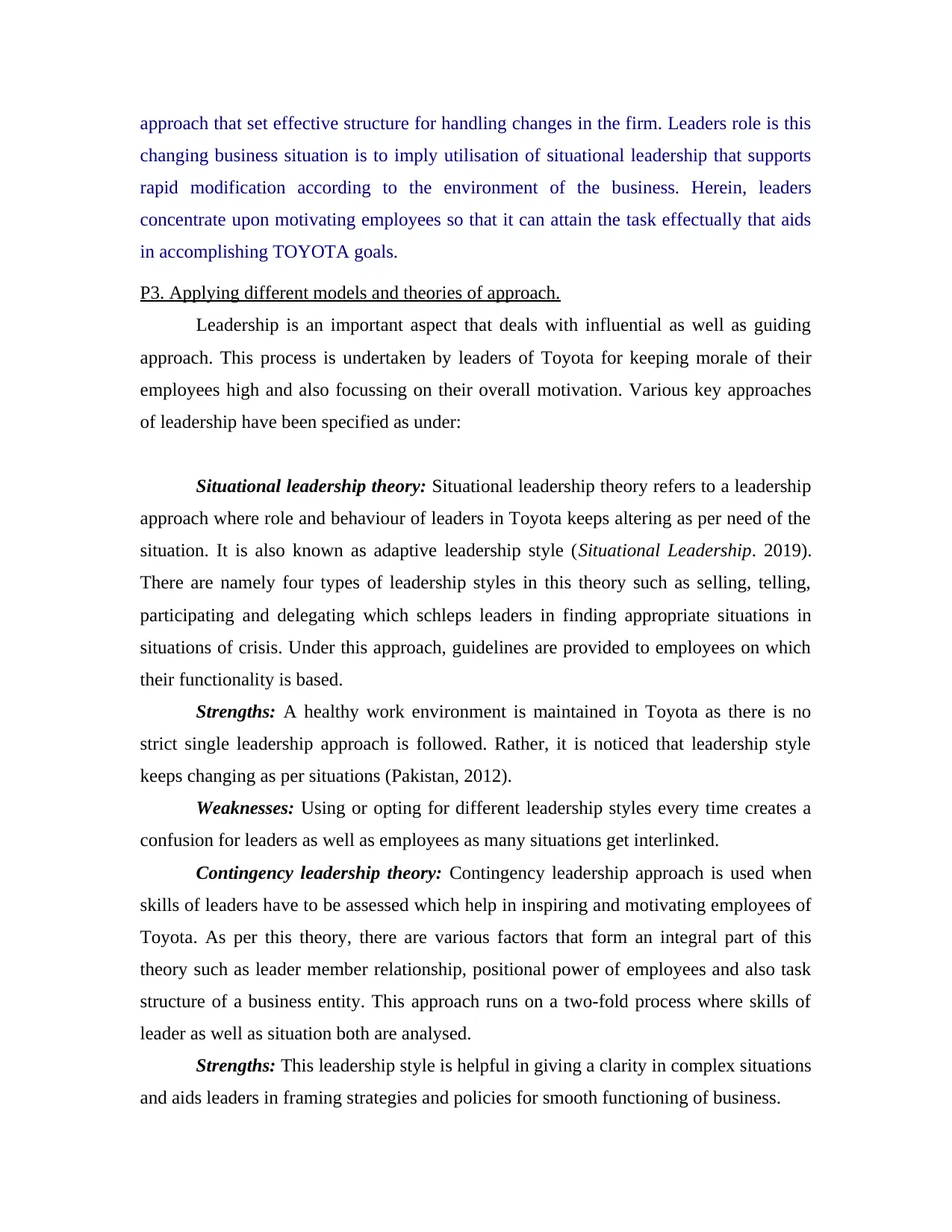
approach that set effective structure for handling changes in the firm. Leaders role is this
changing business situation is to imply utilisation of situational leadership that supports
rapid modification according to the environment of the business. Herein, leaders
concentrate upon motivating employees so that it can attain the task effectually that aids
in accomplishing TOYOTA goals.
P3. Applying different models and theories of approach.
Leadership is an important aspect that deals with influential as well as guiding
approach. This process is undertaken by leaders of Toyota for keeping morale of their
employees high and also focussing on their overall motivation. Various key approaches
of leadership have been specified as under:
Situational leadership theory: Situational leadership theory refers to a leadership
approach where role and behaviour of leaders in Toyota keeps altering as per need of the
situation. It is also known as adaptive leadership style (Situational Leadership. 2019).
There are namely four types of leadership styles in this theory such as selling, telling,
participating and delegating which schleps leaders in finding appropriate situations in
situations of crisis. Under this approach, guidelines are provided to employees on which
their functionality is based.
Strengths: A healthy work environment is maintained in Toyota as there is no
strict single leadership approach is followed. Rather, it is noticed that leadership style
keeps changing as per situations (Pakistan, 2012).
Weaknesses: Using or opting for different leadership styles every time creates a
confusion for leaders as well as employees as many situations get interlinked.
Contingency leadership theory: Contingency leadership approach is used when
skills of leaders have to be assessed which help in inspiring and motivating employees of
Toyota. As per this theory, there are various factors that form an integral part of this
theory such as leader member relationship, positional power of employees and also task
structure of a business entity. This approach runs on a two-fold process where skills of
leader as well as situation both are analysed.
Strengths: This leadership style is helpful in giving a clarity in complex situations
and aids leaders in framing strategies and policies for smooth functioning of business.
changing business situation is to imply utilisation of situational leadership that supports
rapid modification according to the environment of the business. Herein, leaders
concentrate upon motivating employees so that it can attain the task effectually that aids
in accomplishing TOYOTA goals.
P3. Applying different models and theories of approach.
Leadership is an important aspect that deals with influential as well as guiding
approach. This process is undertaken by leaders of Toyota for keeping morale of their
employees high and also focussing on their overall motivation. Various key approaches
of leadership have been specified as under:
Situational leadership theory: Situational leadership theory refers to a leadership
approach where role and behaviour of leaders in Toyota keeps altering as per need of the
situation. It is also known as adaptive leadership style (Situational Leadership. 2019).
There are namely four types of leadership styles in this theory such as selling, telling,
participating and delegating which schleps leaders in finding appropriate situations in
situations of crisis. Under this approach, guidelines are provided to employees on which
their functionality is based.
Strengths: A healthy work environment is maintained in Toyota as there is no
strict single leadership approach is followed. Rather, it is noticed that leadership style
keeps changing as per situations (Pakistan, 2012).
Weaknesses: Using or opting for different leadership styles every time creates a
confusion for leaders as well as employees as many situations get interlinked.
Contingency leadership theory: Contingency leadership approach is used when
skills of leaders have to be assessed which help in inspiring and motivating employees of
Toyota. As per this theory, there are various factors that form an integral part of this
theory such as leader member relationship, positional power of employees and also task
structure of a business entity. This approach runs on a two-fold process where skills of
leader as well as situation both are analysed.
Strengths: This leadership style is helpful in giving a clarity in complex situations
and aids leaders in framing strategies and policies for smooth functioning of business.
⊘ This is a preview!⊘
Do you want full access?
Subscribe today to unlock all pages.

Trusted by 1+ million students worldwide
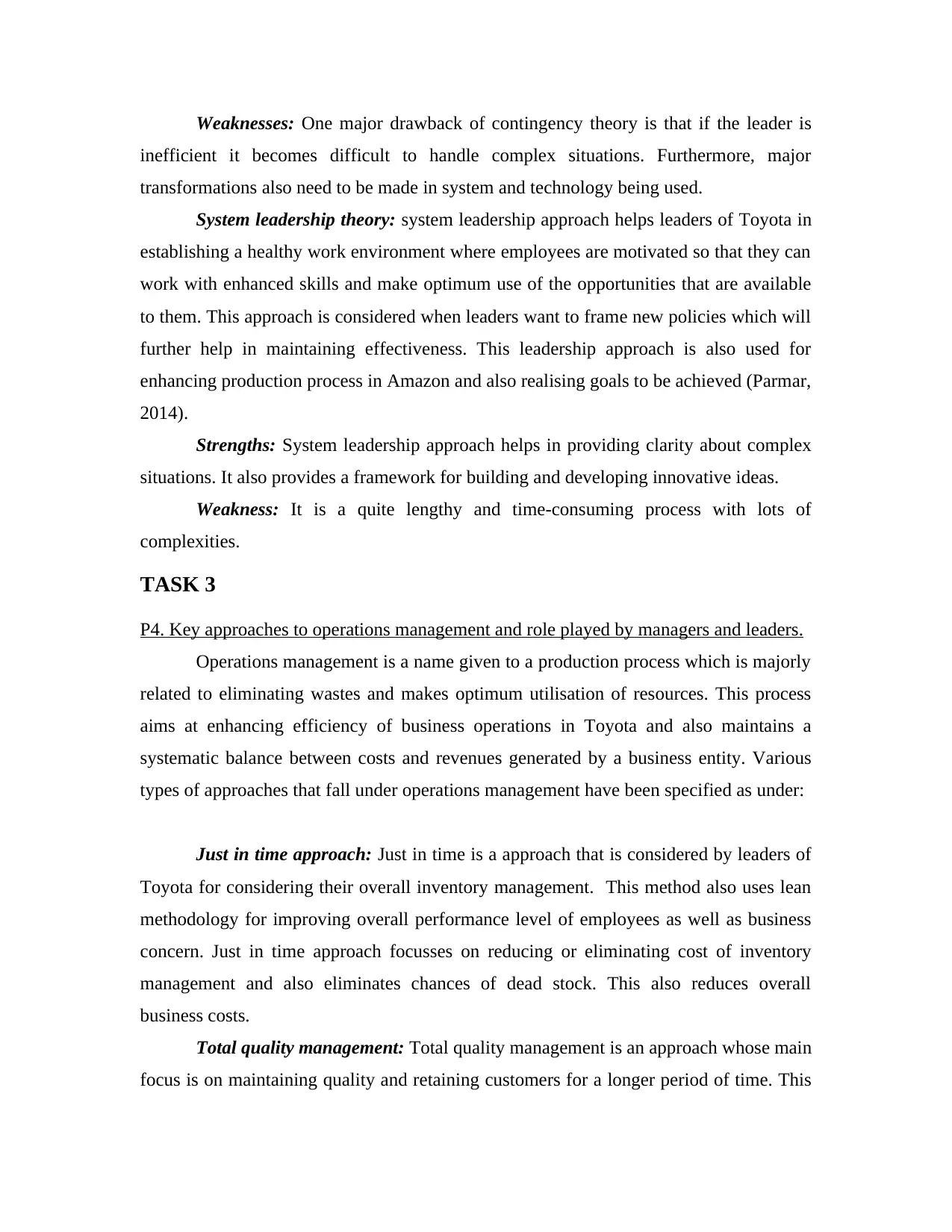
Weaknesses: One major drawback of contingency theory is that if the leader is
inefficient it becomes difficult to handle complex situations. Furthermore, major
transformations also need to be made in system and technology being used.
System leadership theory: system leadership approach helps leaders of Toyota in
establishing a healthy work environment where employees are motivated so that they can
work with enhanced skills and make optimum use of the opportunities that are available
to them. This approach is considered when leaders want to frame new policies which will
further help in maintaining effectiveness. This leadership approach is also used for
enhancing production process in Amazon and also realising goals to be achieved (Parmar,
2014).
Strengths: System leadership approach helps in providing clarity about complex
situations. It also provides a framework for building and developing innovative ideas.
Weakness: It is a quite lengthy and time-consuming process with lots of
complexities.
TASK 3
P4. Key approaches to operations management and role played by managers and leaders.
Operations management is a name given to a production process which is majorly
related to eliminating wastes and makes optimum utilisation of resources. This process
aims at enhancing efficiency of business operations in Toyota and also maintains a
systematic balance between costs and revenues generated by a business entity. Various
types of approaches that fall under operations management have been specified as under:
Just in time approach: Just in time is a approach that is considered by leaders of
Toyota for considering their overall inventory management. This method also uses lean
methodology for improving overall performance level of employees as well as business
concern. Just in time approach focusses on reducing or eliminating cost of inventory
management and also eliminates chances of dead stock. This also reduces overall
business costs.
Total quality management: Total quality management is an approach whose main
focus is on maintaining quality and retaining customers for a longer period of time. This
inefficient it becomes difficult to handle complex situations. Furthermore, major
transformations also need to be made in system and technology being used.
System leadership theory: system leadership approach helps leaders of Toyota in
establishing a healthy work environment where employees are motivated so that they can
work with enhanced skills and make optimum use of the opportunities that are available
to them. This approach is considered when leaders want to frame new policies which will
further help in maintaining effectiveness. This leadership approach is also used for
enhancing production process in Amazon and also realising goals to be achieved (Parmar,
2014).
Strengths: System leadership approach helps in providing clarity about complex
situations. It also provides a framework for building and developing innovative ideas.
Weakness: It is a quite lengthy and time-consuming process with lots of
complexities.
TASK 3
P4. Key approaches to operations management and role played by managers and leaders.
Operations management is a name given to a production process which is majorly
related to eliminating wastes and makes optimum utilisation of resources. This process
aims at enhancing efficiency of business operations in Toyota and also maintains a
systematic balance between costs and revenues generated by a business entity. Various
types of approaches that fall under operations management have been specified as under:
Just in time approach: Just in time is a approach that is considered by leaders of
Toyota for considering their overall inventory management. This method also uses lean
methodology for improving overall performance level of employees as well as business
concern. Just in time approach focusses on reducing or eliminating cost of inventory
management and also eliminates chances of dead stock. This also reduces overall
business costs.
Total quality management: Total quality management is an approach whose main
focus is on maintaining quality and retaining customers for a longer period of time. This
Paraphrase This Document
Need a fresh take? Get an instant paraphrase of this document with our AI Paraphraser
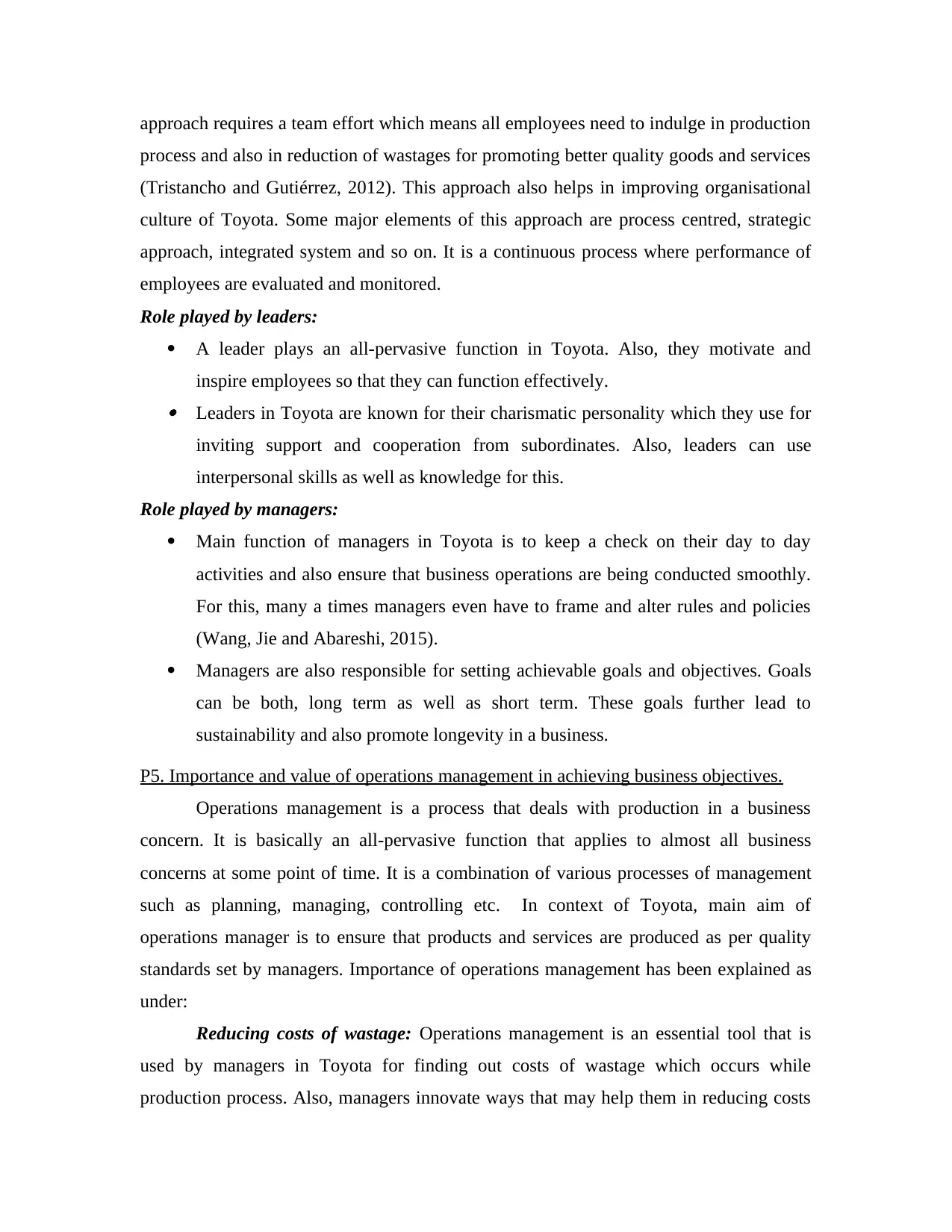
approach requires a team effort which means all employees need to indulge in production
process and also in reduction of wastages for promoting better quality goods and services
(Tristancho and Gutiérrez, 2012). This approach also helps in improving organisational
culture of Toyota. Some major elements of this approach are process centred, strategic
approach, integrated system and so on. It is a continuous process where performance of
employees are evaluated and monitored.
Role played by leaders:
A leader plays an all-pervasive function in Toyota. Also, they motivate and
inspire employees so that they can function effectively.
Leaders in Toyota are known for their charismatic personality which they use for
inviting support and cooperation from subordinates. Also, leaders can use
interpersonal skills as well as knowledge for this.
Role played by managers:
Main function of managers in Toyota is to keep a check on their day to day
activities and also ensure that business operations are being conducted smoothly.
For this, many a times managers even have to frame and alter rules and policies
(Wang, Jie and Abareshi, 2015).
Managers are also responsible for setting achievable goals and objectives. Goals
can be both, long term as well as short term. These goals further lead to
sustainability and also promote longevity in a business.
P5. Importance and value of operations management in achieving business objectives.
Operations management is a process that deals with production in a business
concern. It is basically an all-pervasive function that applies to almost all business
concerns at some point of time. It is a combination of various processes of management
such as planning, managing, controlling etc. In context of Toyota, main aim of
operations manager is to ensure that products and services are produced as per quality
standards set by managers. Importance of operations management has been explained as
under:
Reducing costs of wastage: Operations management is an essential tool that is
used by managers in Toyota for finding out costs of wastage which occurs while
production process. Also, managers innovate ways that may help them in reducing costs
process and also in reduction of wastages for promoting better quality goods and services
(Tristancho and Gutiérrez, 2012). This approach also helps in improving organisational
culture of Toyota. Some major elements of this approach are process centred, strategic
approach, integrated system and so on. It is a continuous process where performance of
employees are evaluated and monitored.
Role played by leaders:
A leader plays an all-pervasive function in Toyota. Also, they motivate and
inspire employees so that they can function effectively.
Leaders in Toyota are known for their charismatic personality which they use for
inviting support and cooperation from subordinates. Also, leaders can use
interpersonal skills as well as knowledge for this.
Role played by managers:
Main function of managers in Toyota is to keep a check on their day to day
activities and also ensure that business operations are being conducted smoothly.
For this, many a times managers even have to frame and alter rules and policies
(Wang, Jie and Abareshi, 2015).
Managers are also responsible for setting achievable goals and objectives. Goals
can be both, long term as well as short term. These goals further lead to
sustainability and also promote longevity in a business.
P5. Importance and value of operations management in achieving business objectives.
Operations management is a process that deals with production in a business
concern. It is basically an all-pervasive function that applies to almost all business
concerns at some point of time. It is a combination of various processes of management
such as planning, managing, controlling etc. In context of Toyota, main aim of
operations manager is to ensure that products and services are produced as per quality
standards set by managers. Importance of operations management has been explained as
under:
Reducing costs of wastage: Operations management is an essential tool that is
used by managers in Toyota for finding out costs of wastage which occurs while
production process. Also, managers innovate ways that may help them in reducing costs
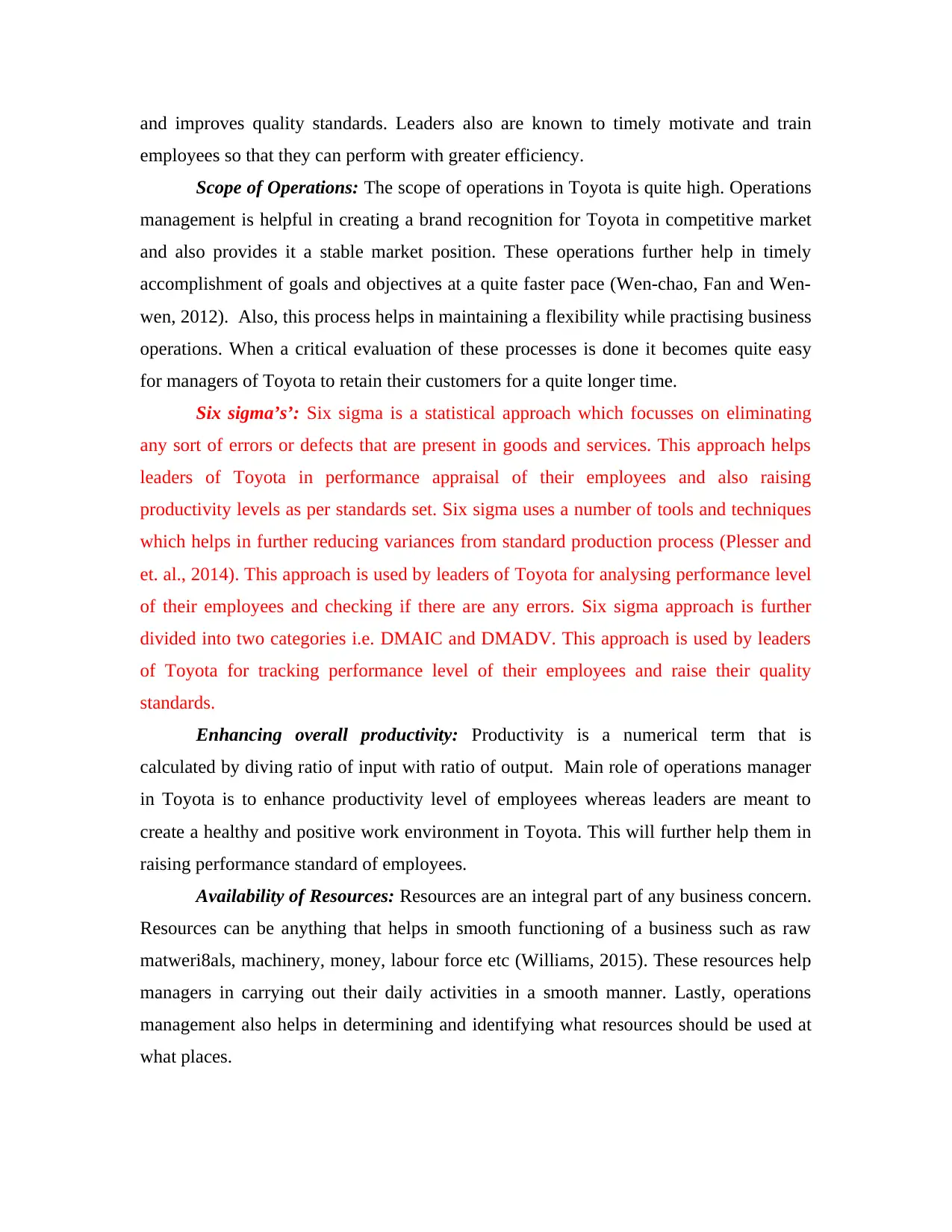
and improves quality standards. Leaders also are known to timely motivate and train
employees so that they can perform with greater efficiency.
Scope of Operations: The scope of operations in Toyota is quite high. Operations
management is helpful in creating a brand recognition for Toyota in competitive market
and also provides it a stable market position. These operations further help in timely
accomplishment of goals and objectives at a quite faster pace (Wen-chao, Fan and Wen-
wen, 2012). Also, this process helps in maintaining a flexibility while practising business
operations. When a critical evaluation of these processes is done it becomes quite easy
for managers of Toyota to retain their customers for a quite longer time.
Six sigma’s’: Six sigma is a statistical approach which focusses on eliminating
any sort of errors or defects that are present in goods and services. This approach helps
leaders of Toyota in performance appraisal of their employees and also raising
productivity levels as per standards set. Six sigma uses a number of tools and techniques
which helps in further reducing variances from standard production process (Plesser and
et. al., 2014). This approach is used by leaders of Toyota for analysing performance level
of their employees and checking if there are any errors. Six sigma approach is further
divided into two categories i.e. DMAIC and DMADV. This approach is used by leaders
of Toyota for tracking performance level of their employees and raise their quality
standards.
Enhancing overall productivity: Productivity is a numerical term that is
calculated by diving ratio of input with ratio of output. Main role of operations manager
in Toyota is to enhance productivity level of employees whereas leaders are meant to
create a healthy and positive work environment in Toyota. This will further help them in
raising performance standard of employees.
Availability of Resources: Resources are an integral part of any business concern.
Resources can be anything that helps in smooth functioning of a business such as raw
matweri8als, machinery, money, labour force etc (Williams, 2015). These resources help
managers in carrying out their daily activities in a smooth manner. Lastly, operations
management also helps in determining and identifying what resources should be used at
what places.
employees so that they can perform with greater efficiency.
Scope of Operations: The scope of operations in Toyota is quite high. Operations
management is helpful in creating a brand recognition for Toyota in competitive market
and also provides it a stable market position. These operations further help in timely
accomplishment of goals and objectives at a quite faster pace (Wen-chao, Fan and Wen-
wen, 2012). Also, this process helps in maintaining a flexibility while practising business
operations. When a critical evaluation of these processes is done it becomes quite easy
for managers of Toyota to retain their customers for a quite longer time.
Six sigma’s’: Six sigma is a statistical approach which focusses on eliminating
any sort of errors or defects that are present in goods and services. This approach helps
leaders of Toyota in performance appraisal of their employees and also raising
productivity levels as per standards set. Six sigma uses a number of tools and techniques
which helps in further reducing variances from standard production process (Plesser and
et. al., 2014). This approach is used by leaders of Toyota for analysing performance level
of their employees and checking if there are any errors. Six sigma approach is further
divided into two categories i.e. DMAIC and DMADV. This approach is used by leaders
of Toyota for tracking performance level of their employees and raise their quality
standards.
Enhancing overall productivity: Productivity is a numerical term that is
calculated by diving ratio of input with ratio of output. Main role of operations manager
in Toyota is to enhance productivity level of employees whereas leaders are meant to
create a healthy and positive work environment in Toyota. This will further help them in
raising performance standard of employees.
Availability of Resources: Resources are an integral part of any business concern.
Resources can be anything that helps in smooth functioning of a business such as raw
matweri8als, machinery, money, labour force etc (Williams, 2015). These resources help
managers in carrying out their daily activities in a smooth manner. Lastly, operations
management also helps in determining and identifying what resources should be used at
what places.
⊘ This is a preview!⊘
Do you want full access?
Subscribe today to unlock all pages.

Trusted by 1+ million students worldwide
1 out of 17
Related Documents
Your All-in-One AI-Powered Toolkit for Academic Success.
+13062052269
info@desklib.com
Available 24*7 on WhatsApp / Email
![[object Object]](/_next/static/media/star-bottom.7253800d.svg)
Unlock your academic potential
Copyright © 2020–2025 A2Z Services. All Rights Reserved. Developed and managed by ZUCOL.





